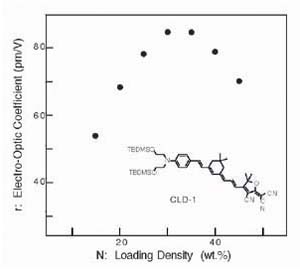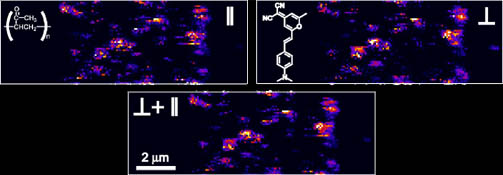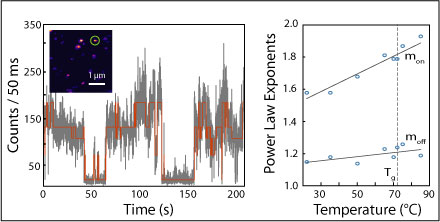


Organic materials will play an important role in a variety of next-generation photonic applications ranging from telecommunications to solar-energy harvesting. However, fulfilling the promise of these materials is dependent on understanding the molecular details that currently limit their overall efficiency with regards to performance and stability. Our efforts in photonics involve two activities: the development and characterization of enhanced second-order non-linear optical materials, and control of the photophysics that results in material decomposition.
Modern NLO materials consist of non-linear organic molecules imbedded into polymer matrices. The central issue in the development of these materials is the translation of molecular systems with large non-linear behavior into macroscopic assemblies having a correspondingly large NLO activity. This issue is nicely illustrated in the following figure where the macroscopic NLO efficiency cast in terms of the electro-optic coefficient (r) is plotted versus chromophore concentration (expressed as number density, N) for the chromophore CLD in the polymer poly(methyl methacrylate). The figure illustrates that at low loadings r increases proportionally with N; however, a maximum is eventually reached with continued loading resulting in a reduction in electro-optical activity. The position of the maximum depends on molecular properties such as shape and dipole moment. This observation suggests that the chromophore properties in combination with the polymer define the maximum achievable EO activity. If the molecular details behind the reduction in EO activity at high loading density can be understood, then a rational path towards the development of more efficient EO materials can be defined.

Our research in this area involves the characterization of non-linear optical materials from single molecules up to molecular assemblies. Chromophore non-linear optical activity is characterized using frequency-agile hyper-Rayleigh spectroscopy. The intensity of hyper-Rayleigh scattering can be used to determine the non-linear optical performance of individual chromophores. This research is performed in close collaboration with other scientists paticipating in the Science and Technology Center for Materials and Devices for Information Technology Research (CMDITR) supported by the NSF (Click here to link to the CMDITR website). The information gained in these studies is critical in identifying the most promising compounds for use in device applications. Characterization of chromophore-polymer composite materials is performed using standard confocal and non-linear optical microscopy. These techniques combines 3-dimensional spatial resolution with single-molecule sensitivity allowing for detailed studies of chromophore-doped systems. We use the linear-dichroism of the chromophore emission to measure molecular alignment as a function of number density and poling voltage, and directly compare this information to predictions of molecular order derived from Monte-Carlo simulations. Through such comparisons, accurate theoretical methods will be developed thereby increasing the predictive ability of these techniques. For example, the following figures present fluorescence images of the laser dye DCM dispersed in the polymer polymethyl acrylate (PMA). The images correspond to polarization components of the emission that are parallel and perpendicular to an applied electric field. One can measure these components as a function of time to determine the orientation of the molecule, and to follow the rotational dynamics. By measuring the perturbation of the rotational dynamics with the application of the electric field, we are learning about one of the fundamental steps in device construction, electric-field poling to induce molecular alignment.

A well-recognized limitation of organic-photonic materials is that they are not as robust as their inorganic counterparts. Implementation of organic materials for a variety of processes (including information processing, photovoltaics, and light-emitting devices) hinges on understanding the processes that result in material decomposition, and ultimately the control of these processes. Bulk measurements of material decomposition are hindered by the inability to distinguish between the myriad of individual molecular decomposition pathways that may be operative in a material. Developing experimental techniques that provide insight into the decay processes of individual molecules is a significant challenge. One method used to measure single-molecule photophysics is the analysis of the time-dependence of single-molecule emission. Specifically, a single molecule is subjected to continuous photoexcitation and the variation of the emission with time is measured. A common signature of single-molecule emission is intermittency or “blinking” as shown figure below. Notice that the emission is characterized by switching between emissive (“on times”) and non-emissive intervals (“off times”). We are interested in identifying the nature of the the non-emissive state that potentially serves as a gateway state to decomposition, and controlling the population and depopulation kinetics of this dark state.
Typically, the observation of single-molecule blinking has been taken as evidence for molecules undergoing excursions to the triplet state. However, the blinking statistics of our systems are not consistent with this hypothesis since the observed timescales are inconsistent with the known intersystem-crossing rates. Furthermore, the rate constants we observe vary with time consistent with so-called “dispersed kinetics”. Etiologies proposed for distributed kinetics include molecular rotation, conformational flexibility, spectral diffusion, reversible photo-oxidation, intermolecular electron transfer, and proton transfer. We are performing experiments on a variety of materials in an attempt to differentiate between these various mechanisms. We are studying chromophore-polymer systems and investigating the dependence of dark-state population/depopulation kinetics on temperature (relative to the glass-transition temperature of the polymer host), chromophore structure, and structure of the polymer host. The below figure presents recent results from our lab where blinking was used to measure the temperature-dependent photophysics of the chromophore violamine R dispersed in poly(vinyl alcohol). Surprisingly, the blinking statistics were found be relatively invariant for temperatures around the glass-transition temperature of the polymer host. This indicates that the local molecular environment remains relatively consistent around the glass-transition temperature although the bulk viscosity of the host is undergoing a substantial change, and illustrates the importance of probing molecular photophysics on the molecular scale.

Our group also collaborates with the Kahr Group at New York University in the investigation mixed-crystal systems where single molecules are isolated in molecular crystals. This approach allows us to investigate single-molecule photophysics in well-defined environments since the crystal is ordered and restrictive with respect to translation and rotation of guest molecules. In addition, molecular bleaching due to photo-oxidation is reduced relative to oxygen-permeable matrices, and the decrease in nonradiative relaxation caused by the restrictive environment both afford enhanced photostability. These mixed-crystal materials are the optimal system for investigating single-molecule photophysics; in particular, determining the nature of the non-emissive state, its population and depopulations kinetics, as well as the coupling of the dark state to photo-decomposition pathways. Our experimental results are compared to theory in order to elucidate the energetic and kinetic details of dark-state production and decay. Recently we have determined that the dispersed-kinetic behaviour observed for 2’,7’-dichlorofluorescein isolated in postassium acid phthalate (KAP) arises from proton transfer. We are exploring this hypothesis through a variety of studies including structural variation of the chromophore and host, isotopic substitution, and direct control over dielectric fluctuations of the crystal which serve to promote proton transfer.
